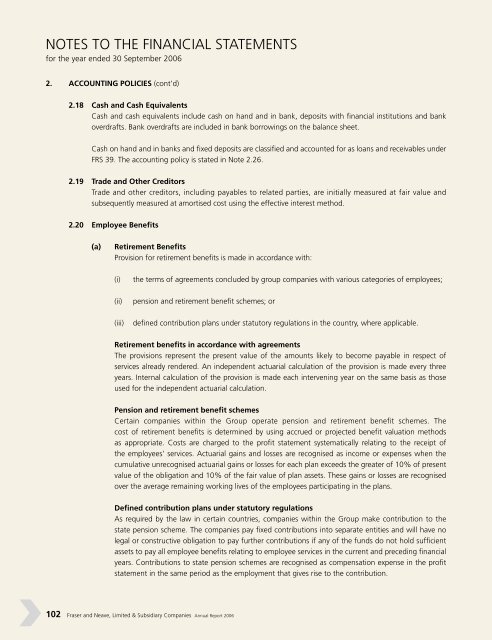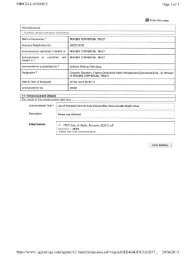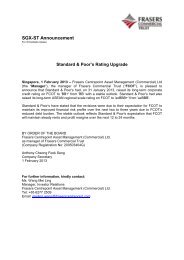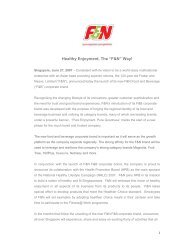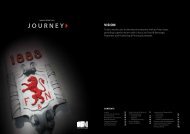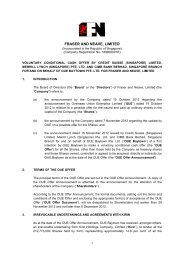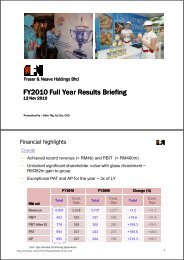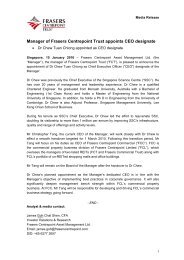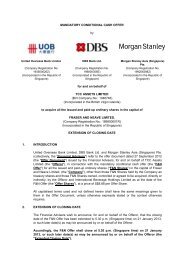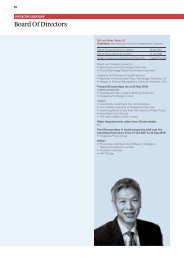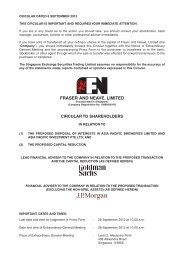Full Report - Fraser and Neave Limited
Full Report - Fraser and Neave Limited
Full Report - Fraser and Neave Limited
Create successful ePaper yourself
Turn your PDF publications into a flip-book with our unique Google optimized e-Paper software.
NOTES TO THE FINANCIAL STATEMENTS<br />
for the year ended 30 September 2006<br />
2. ACCOUNTING POLICIES (cont’d)<br />
2.18 Cash <strong>and</strong> Cash Equivalents<br />
Cash <strong>and</strong> cash equivalents include cash on h<strong>and</strong> <strong>and</strong> in bank, deposits with financial institutions <strong>and</strong> bank<br />
overdrafts. Bank overdrafts are included in bank borrowings on the balance sheet.<br />
Cash on h<strong>and</strong> <strong>and</strong> in banks <strong>and</strong> fixed deposits are classified <strong>and</strong> accounted for as loans <strong>and</strong> receivables under<br />
FRS 39. The accounting policy is stated in Note 2.26.<br />
2.19 Trade <strong>and</strong> Other Creditors<br />
Trade <strong>and</strong> other creditors, including payables to related parties, are initially measured at fair value <strong>and</strong><br />
subsequently measured at amortised cost using the effective interest method.<br />
2.20 Employee Benefits<br />
(a) Retirement Benefits<br />
Provision for retirement benefits is made in accordance with:<br />
(i) the terms of agreements concluded by group companies with various categories of employees;<br />
(ii) pension <strong>and</strong> retirement benefit schemes; or<br />
(iii) defined contribution plans under statutory regulations in the country, where applicable.<br />
Retirement benefits in accordance with agreements<br />
The provisions represent the present value of the amounts likely to become payable in respect of<br />
services already rendered. An independent actuarial calculation of the provision is made every three<br />
years. Internal calculation of the provision is made each intervening year on the same basis as those<br />
used for the independent actuarial calculation.<br />
Pension <strong>and</strong> retirement benefit schemes<br />
Certain companies within the Group operate pension <strong>and</strong> retirement benefit schemes. The<br />
cost of retirement benefits is determined by using accrued or projected benefit valuation methods<br />
as appropriate. Costs are charged to the profit statement systematically relating to the receipt of<br />
the employees’ services. Actuarial gains <strong>and</strong> losses are recognised as income or expenses when the<br />
cumulative unrecognised actuarial gains or losses for each plan exceeds the greater of 10% of present<br />
value of the obligation <strong>and</strong> 10% of the fair value of plan assets. These gains or losses are recognised<br />
over the average remaining working lives of the employees participating in the plans.<br />
Defined contribution plans under statutory regulations<br />
As required by the law in certain countries, companies within the Group make contribution to the<br />
state pension scheme. The companies pay fixed contributions into separate entities <strong>and</strong> will have no<br />
legal or constructive obligation to pay further contributions if any of the funds do not hold sufficient<br />
assets to pay all employee benefits relating to employee services in the current <strong>and</strong> preceding financial<br />
years. Contributions to state pension schemes are recognised as compensation expense in the profit<br />
statement in the same period as the employment that gives rise to the contribution.<br />
102 <strong>Fraser</strong> <strong>and</strong> <strong>Neave</strong>, <strong>Limited</strong> & Subsidiary Companies Annual <strong>Report</strong> 2006


